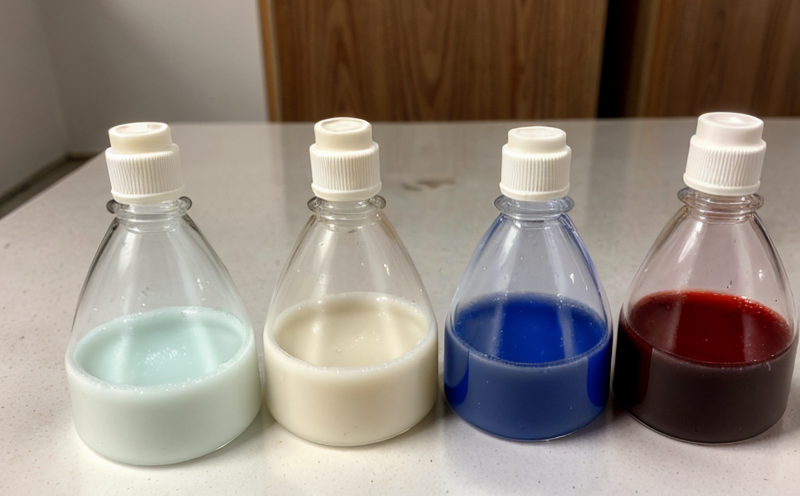Paint Monomer Content Testing
The paint monomer content testing service is critical in ensuring that paints and coatings meet stringent quality standards. This rigorous analytical process aims to identify and quantify volatile organic compounds (VOCs), solvents, monomers, and oligomers present in the paint formulation. Understanding these components is essential for compliance with environmental regulations such as REACH (Registration, Evaluation, Authorisation and Restriction of Chemicals) in Europe, TSCA (Toxic Substances Control Act) in the United States, and similar national laws.
Monomers play a pivotal role in polymer synthesis. In paints, they are typically used to form polymeric networks that enhance film properties like adhesion, flexibility, and durability. However, improper use or unintended by-products can lead to hazardous emissions during application or drying processes. Therefore, precise quantification of these constituents is crucial for maintaining product safety and efficacy.
The testing methodology involves several stages including sample collection, preparation, analysis using gas chromatography (GC) coupled with mass spectrometry (GC-MS), and interpretation based on standard reference materials. Compliance with ISO 15223:2004 'Polyurethane coatings – Determination of free isocyanate content' or ASTM D4769 provides a robust framework for accurate measurement.
Accurate determination of monomer levels not only ensures adherence to regulatory requirements but also supports innovation within the paint industry. By optimizing formulations through detailed analysis, manufacturers can develop more sustainable products that reduce environmental impact while maintaining performance standards.
Moreover, understanding the behavior of monomers helps predict potential health risks associated with exposure during production or end-use applications. This knowledge guides formulation adjustments aimed at minimizing adverse effects on human health and ecosystem balance.
Why Choose This Test
Choosing paint monomer content testing services offers numerous advantages that are beneficial for various stakeholders in the coatings industry:
- Regulatory Compliance: Ensures adherence to international standards and local regulations.
- Safety Assurance: Identifies hazardous compounds that may pose risks during application or use.
- Product Quality Improvement: Optimizes paint composition for enhanced performance attributes.
- Innovation Facilitation: Provides insights into novel material interactions and potential improvements in formulation design.
By leveraging advanced analytical techniques, our laboratory ensures accurate detection of even trace amounts of monomers. This precision is vital for maintaining consistent quality across batches and ensuring that products meet the highest standards of safety and efficacy.
Quality and Reliability Assurance
The reliability of paint monomer content testing results depends on several factors, including sample preparation, instrumentation calibration, operator expertise, and adherence to established protocols. At our facility, we employ state-of-the-art equipment such as high-performance liquid chromatography (HPLC) and Fourier transform infrared spectroscopy (FTIR), which provide precise measurements.
To ensure accuracy, all samples undergo rigorous preprocessing steps that involve dissolution in appropriate solvents followed by filtration if necessary. Samples are then injected into the GC-MS system for separation and identification of individual components based on retention times and mass spectra patterns.
Our team of trained professionals follows strict procedures outlined in relevant standards like ISO 15223:2004 or ASTM D4769, ensuring consistent quality throughout each step. Regular calibration checks are performed to maintain instrument performance at optimal levels.
The reliability of our testing services is further enhanced by extensive quality control measures including internal audits, inter-laboratory comparisons, and participation in proficiency testing programs recognized globally. These initiatives help us stay abreast of emerging trends and challenges within the industry, allowing us to provide timely updates and recommendations based on evolving best practices.
Use Cases and Application Examples
| Application Scenario | Description |
|---|---|
| New Product Development | Determining the optimal balance of monomers for achieving desired properties while minimizing environmental impact. |
| Quality Control During Production | Monitoring batch consistency and identifying potential deviations from specified limits. |
| Compliance Verification | Ensuring that final products comply with regulatory requirements regarding VOC content. |
| R&D Optimization | Evaluating different monomer combinations to enhance paint durability or reduce curing time. |
| Environmental Impact Assessment | Identifying harmful substances present in paints that could affect air quality during application. |
| Sustainability Initiatives | Developing more eco-friendly alternatives by replacing traditional monomers with less toxic ones. |
| Customer Satisfaction Enhancement | Providing transparent information about paint ingredients to satisfy consumer demand for transparency and safety. |
The ability to accurately measure monomer content enables stakeholders across the supply chain—from raw material suppliers to manufacturers—to make informed decisions that drive innovation while ensuring compliance with regulatory requirements. This comprehensive approach supports sustainable practices and fosters trust among consumers regarding product quality and safety.





